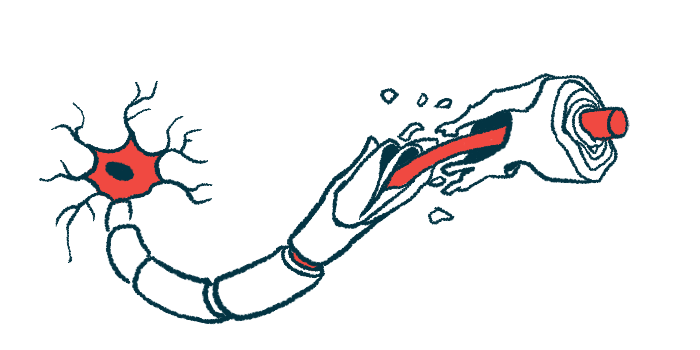Glycosylation May Underlie Effects of Some CMT1B Mutations
Protein modification with gain-of-glycosylation seen to disrupt myelin in mice
Written by |

Too much glycosylation, a protein modification process, may underlie the effects of some mutations in the MPZ gene, the gene responsible for Charcot-Marie-Tooth disease type 1B (CMT1B), a study found.
Suggestions this might be the case were supported by findings from a new mouse model of CMT1B, in which a certain mutation caused excess glycosylation, leading to significant alterations to the myelin sheath and disease symptoms.
Study findings, overall, identify gain-of-glycosylation “as a novel pathomechanism of disease,” the researchers wrote.
The study, “A novel mouse model of CMT1B identifies hyperglycosylation as a new pathogenetic mechanism,” was published in the journal Human Molecular Genetics.
MPZ contains instructions for making the myelin protein zero, called P0. P0 is a component of the myelin sheath, the fatty protective substance that surrounds and protects nerve cell fibers and helps speed cell-to-cell communication.
When P0 is defective, as in CMT1B, the formation and maintenance of myelin is disrupted, leading to impaired signaling among peripheral nerves, those outside the brain and spinal cord.
Excess glycosylation in mice disrupts the myelin sheath
More than 100 mutations in MPZ have been identified, and disease severity and age of onset varies significantly among patients, suggesting that different mutations have different cellular effects.
Disruptions to the normal glycosylation of P0 have been proposed as mechanism by which some mutations might act. Glycosylation is a type of protein modification in which sugars are attached to a protein’s backbone, modulating its function.
An international team of researchers, led by those in Italy, aimed to explore in more detail the effects of MPZ mutations thought to affect glycosylation. The scientists identified several mutations, some of which would cause too much glycosylation — hyperglycosylated mutations — and others causing too little, known as hypoglycosylated mutations.
Schwann cells, the cells involved in myelinating the peripheral nerves, were engineered to contain each mutation in cell cultures. Overall, the hyperglycosylating mutations appeared to be more detrimental to the cells than hypoglycosylating ones.
Specifically, the hyperglycosylated mutations prevented P0 from entirely reaching the Schwann cell membrane, where it normally resides. These mutations also inhibited P0’s ability to help layers of myelin properly adhere to nerve cells and to one another — a critical function the protein normally plays.
“Altogether these data indicate that the hyperglycosylated mutations, but not the hypoglycosylated ones, interfered with protein localization and protein adhesion properties, supporting the hypothesis that gain-of-glycosylation is more disruptive as compared to loss-of-glycosylation,” the researchers wrote.
To explore further, the researchers developed a mouse model containing one of these hyperglycosylated mutations, the D61N mutation, that has been seen in CMT1B patients.
They found that mice with the mutation had symptoms similar to CMT1B patients. At a young age, the animals developed a progressively worsening tremor, and demonstrated significant motor impairments and reduced muscle strength. Nerve cells from the mice also had altered electrical signaling properties that progressively worsened, arriving at the point of being unrecordable or “dramatically impaired” later in life.
Significant disruptions to the myelin sheath were also observed in the sciatic nerve — a large nerve that runs from the base of the spine down the leg — of mutant mice compared with healthy mice.
Specifically, the mutated mice had reduced myelin thickness overall, but with areas of myelin sheath swelling, called tomaculas, that worsened over time. Proper formation of the myelin layers was disturbed, with regions where the layers were decompacted.
Signs of nerve cell degeneration and inflammation were also observed in mutant mice but not in healthy ones.
A genetic sequencing analysis revealed that the mutation caused altered levels of genes related to Schwann cell development and the structure of the extracellular matrix — a network of structural proteins and other components that play a role in forming myelin — altogether indicating a “striking dysregulation” of these pathways, the team wrote.
Findings may have ‘therapeutic implications’ for patients
“Identification of these pathways offers some potential therapeutic targets that will be investigated further,” the researchers wrote.
“By establishing the first knock-in mouse expressing an authentic gain-of-glycosylation mutation in P0, we provided evidence that the resulting severe CMT1B neuropathy is likely due to a gain-of-function in myelin, with important implications for future therapeutic approaches,” they added.
Finally, the team tested whether miglustat might reverse some of the effects of the D61N mutation. Miglustat belongs to a class of compounds called imino-sugars that are thought to lower glycosylation levels. It is currently marketed as Zavesca to treat a condition called Gaucher disease type 1.
In cell cultures, the treatment showed an ability to increase P0 trafficking to the cell membrane, improve myelin layer adhesion, and reverse other myelin abnormalities, but it did not appear to lower levels of glycosylation.
“Further studies will be required to elucidate the effects of imino-sugars on protein glycosylation and myelination in [Schwann cells],” the researchers wrote.





